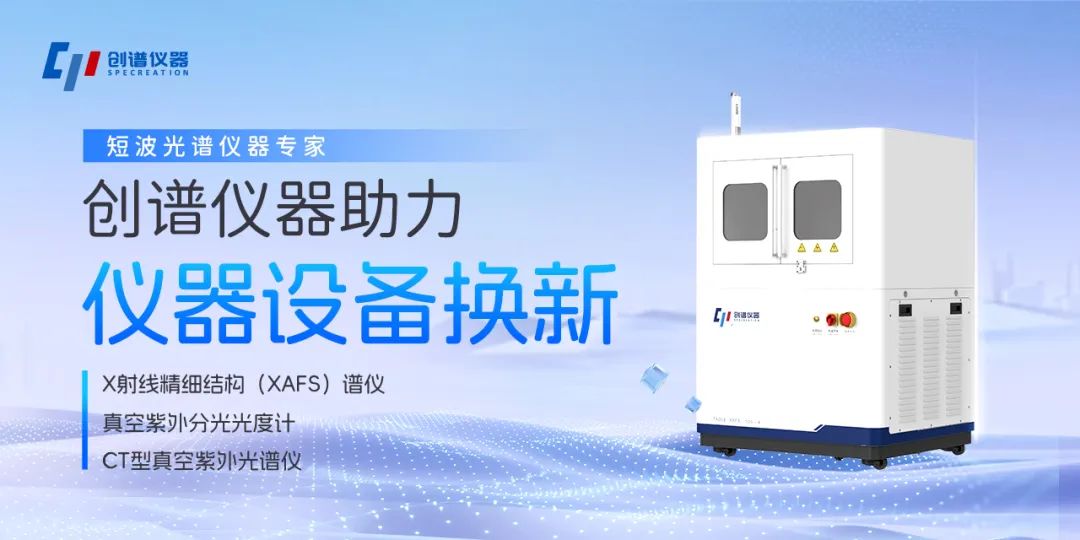
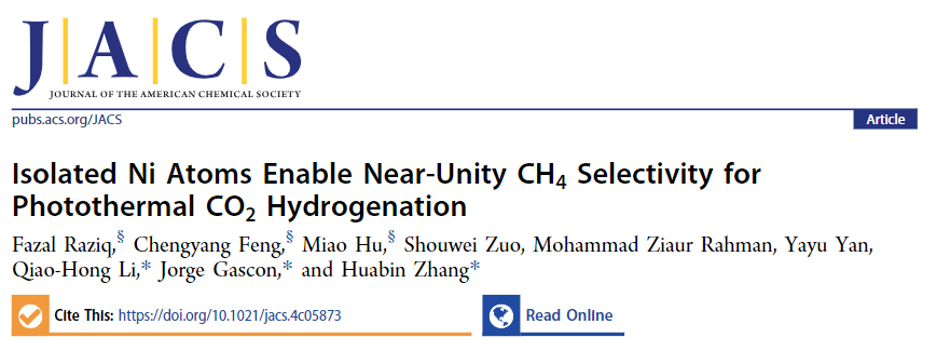 ▲Co-first authors: Fazal Raziq, Chengyang Feng, Miao Hu
▲Co-first authors: Fazal Raziq, Chengyang Feng, Miao Hu
Corresponding authors: Qiaohong Li, Jorge Gascon, Huabin Zhang
Affiliation: King Abdullah University of Science and Technology (KAUST)
Paper DOI: 10.1021/jacs.4c05873 (Click “Read the original text” at the end for direct link)
Photothermal hydrogenation of carbon dioxide (CO2) into value-added products is an ideal solution to address the energy crisis and reduce CO2 emissions. However, achieving high product selectivity remains challenging due to the many competing intermediate reactions occurring during CO2 hydrogenation. We propose a novel approach by anchoring isolated single atom nickel (Ni) on indium oxide (In2O3) nanocrystals as an effective photothermal catalyst for hydrogenating CO2 to methane (CH4) with nearly 100% selectivity. Experimental and theoretical simulations have confirmed that the isolated Ni sites on the In2O3 surface can effectively stabilize the intermediates of the CO2 hydrogenation reaction and lower the transition state energy barrier, thereby altering the reaction pathway to achieve ultra-high selectivity for methanation. This research provides comprehensive insights into the design of single atom catalysts for highly selective photothermal hydrogenation of CO2 to methane.
1. Nearly 100% selectivity for CO2 photothermal hydrogenation to methanation
2. Reveals a CO2 hydrogenation process distinct from the traditional methoxy pathway
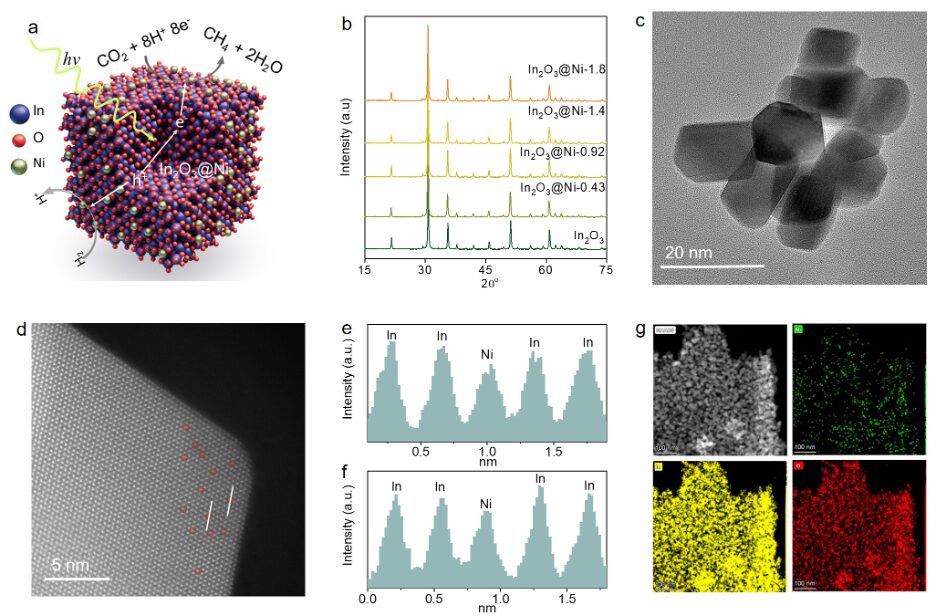 Figure 1. Structural characterization of the catalyst
The Ni single atom catalyst supported on In2O3 was prepared via a simple impregnation-sintering method. HAADF-STEM and HRTEM confirmed the single atom level dispersion of the Ru species.
Figure 1. Structural characterization of the catalyst
The Ni single atom catalyst supported on In2O3 was prepared via a simple impregnation-sintering method. HAADF-STEM and HRTEM confirmed the single atom level dispersion of the Ru species.
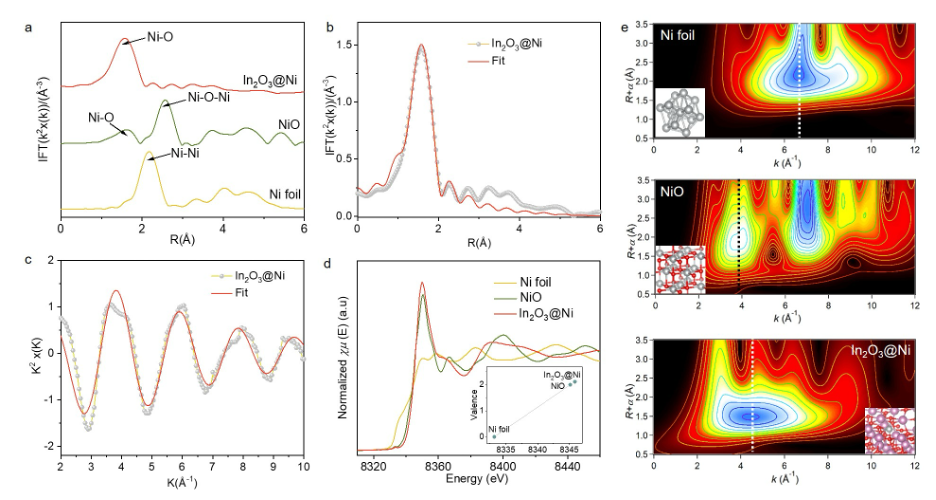 Figure 2. Coordination structure characterization of Ni sites
The electronic structure and coordination of Ni species in the prepared Ni/In2O3 catalyst were studied using synchrotron radiation X-ray absorption spectroscopy (XAS). The atomic-level dispersion of Ni species was confirmed, with the absorption edge fitting indicating a valence state of +2.1 for Ni species.
Figure 2. Coordination structure characterization of Ni sites
The electronic structure and coordination of Ni species in the prepared Ni/In2O3 catalyst were studied using synchrotron radiation X-ray absorption spectroscopy (XAS). The atomic-level dispersion of Ni species was confirmed, with the absorption edge fitting indicating a valence state of +2.1 for Ni species.
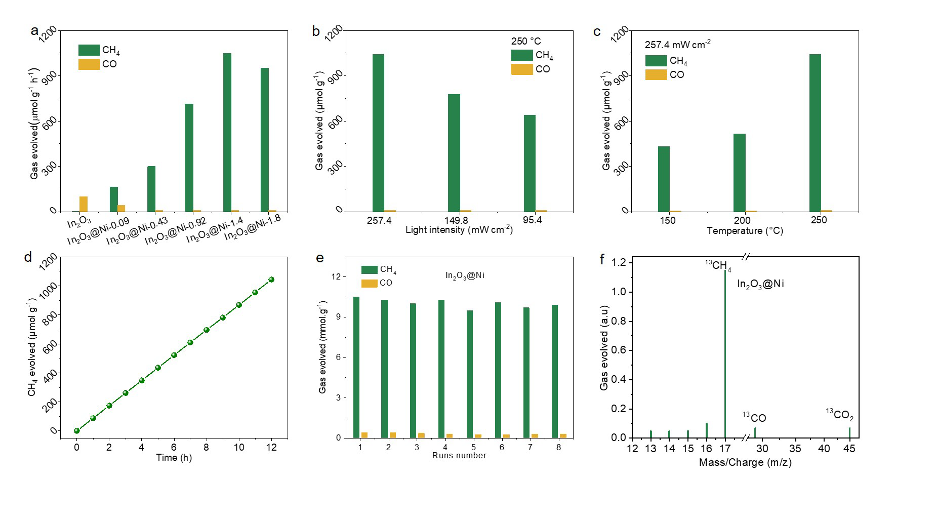 Figure 3. Photothermal CO2 hydrogenation activity testing
The introduction of Ni sites completely transformed the products of CO2 photothermal hydrogenation from CO to CH4, with selectivity approaching 100%.
Figure 3. Photothermal CO2 hydrogenation activity testing
The introduction of Ni sites completely transformed the products of CO2 photothermal hydrogenation from CO to CH4, with selectivity approaching 100%.
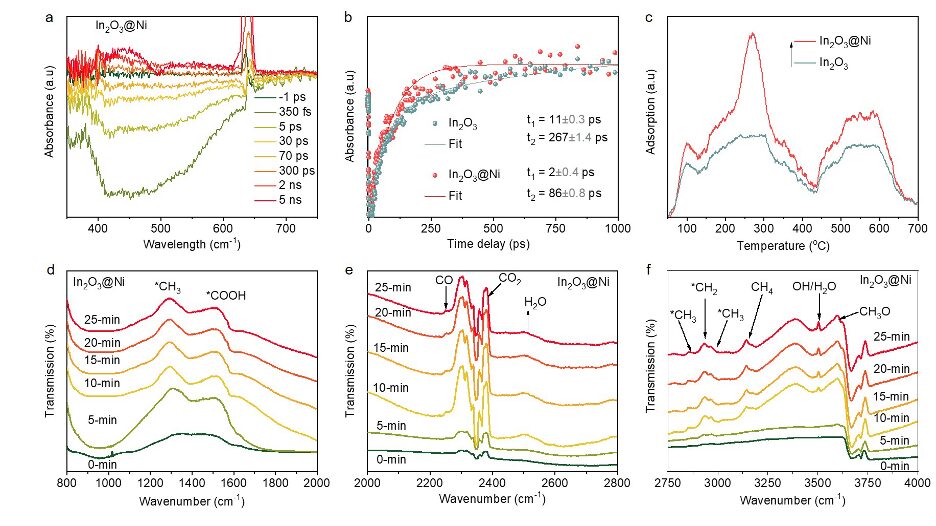 Figure 4. Ultrafast spectroscopy and in situ characterization
Combining ultrafast spectroscopy with exchange experiments, the migration behavior of photogenerated electrons was investigated. The results indicate that the photogenerated electrons produced by In2O3 under light excitation transfer to the Ni sites, forming an electron-rich reactive zone that favors the reduction of CO2. More importantly, in situ experiments demonstrated that the strong adsorption of Ni sites on the key intermediate *CO leads to the selectivity shift.
Figure 4. Ultrafast spectroscopy and in situ characterization
Combining ultrafast spectroscopy with exchange experiments, the migration behavior of photogenerated electrons was investigated. The results indicate that the photogenerated electrons produced by In2O3 under light excitation transfer to the Ni sites, forming an electron-rich reactive zone that favors the reduction of CO2. More importantly, in situ experiments demonstrated that the strong adsorption of Ni sites on the key intermediate *CO leads to the selectivity shift.
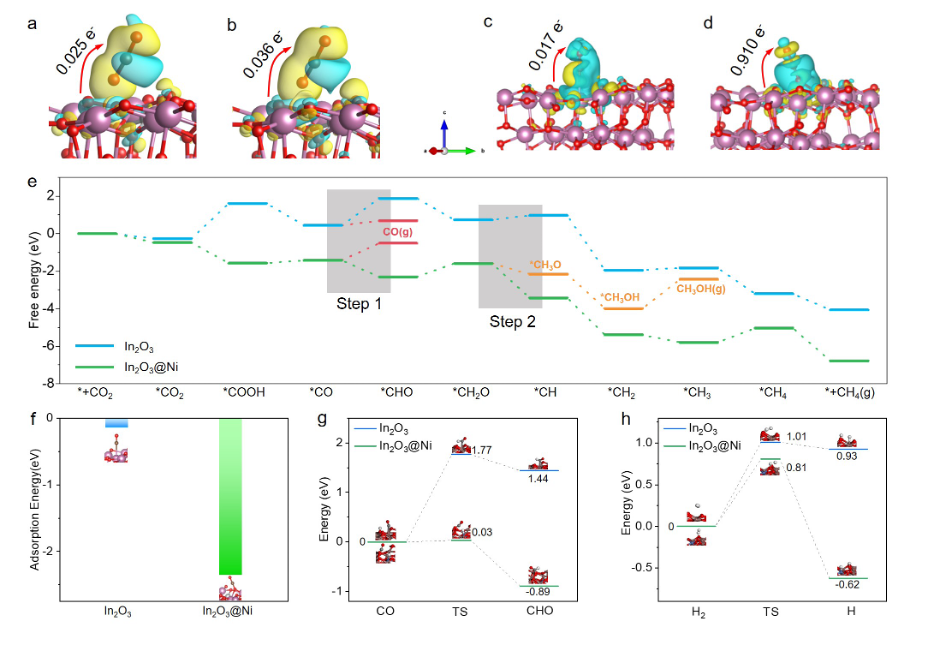 Figure 5. Mechanistic study and theoretical calculations
Combining theoretical calculations, the reaction pathway for CO2 photothermal hydrogenation on Ni sites was revealed, proposing a CO2 hydrogenation process distinct from the traditional methoxy pathway.
In summary, the atomic-level dispersion of Ni on the In2O3 surface can promote photothermal CO2 hydrogenation, achieving CH4 selectivity of up to 99%. Through a series of characterizations, in situ experiments, and first-principles calculations, the physicochemical properties were explored, rate-limiting steps were identified, and reaction pathways were proposed. The excellent performance of the developed catalyst can be attributed to the stabilization of CO* by the isolated Ni sites, lowering the reaction energy barrier for key steps, accelerating H2 dissociation, thereby facilitating CO2 hydrogenation and leading to high selectivity for CH4 production.
Huabin Zhang Professor Profile: Joined King Abdullah University of Science and Technology (KAUST) in December 2020, Department of Chemical Sciences, serving as an independent PI and PhD supervisor. He has been honored with titles such as National High-level Young Talent and the Hundred Talents Program of the Chinese Academy of Sciences. Dr. Zhang obtained his PhD in 2013 from the Chinese Academy of Sciences and served as an assistant researcher there the same year. From 2014 to 2017, he conducted postdoctoral research at the National Institute for Materials Science in Japan. In March 2017, he joined Nanyang Technological University in Singapore as a Research Fellow. He has long been committed to building single-atom catalysts for applications in energy conversion and environmental optimization. He has published over 150 papers/book chapters, with more than 17,000 citations and an H-index of 65. Many articles have been published as first/corresponding authors in renowned international journals such as Sci. Adv., PNAS, Joule, Adv. Mater., Energy Environ. Sci., Angew. Chem. Int. Ed., J. Am. Chem. Soc., Adv. Energy Mater., Adv. Funct. Mater., ACS Nano, and Nano Energy.
https://acse.kaust.edu.sa/
Advanced Catalysis of Sustainable Energy (ACSE), headed by Huabin Zhang (Assistant Professor of Chemistry) in the KAUST Catalysis Center.
The Lab of ACSE focuses on the development of single-atom catalysts with particular configurations for sustainable energy conversion, including photocatalysis, electrocatalysis, and thermal catalysis. Our research also extends to operando investigations for monitoring the structural evolution of the reactive centers, as well as the mutual interaction between the reactive center and reactant in the catalytic process.
1. Summary of Basic Knowledge on Instrument Characterization
2. Summary of SCI Paper Writing Topics
3. Summary of Scientific Visualization Tools such as Origin/3D Drawing
4. Summary of Basic Knowledge in Theoretical Chemistry
5. Summary of Catalysis Section
6. Summary Post on Electrochemistry-Battery Related Content
7. Summary of Renowned Teachers in Research
For more knowledge on scientific illustration, software usage, characterization analysis, SCI writing, and renowned teacher introductions, please enter the backend for self-query.
Figure 5. Mechanistic study and theoretical calculations
Combining theoretical calculations, the reaction pathway for CO2 photothermal hydrogenation on Ni sites was revealed, proposing a CO2 hydrogenation process distinct from the traditional methoxy pathway.
In summary, the atomic-level dispersion of Ni on the In2O3 surface can promote photothermal CO2 hydrogenation, achieving CH4 selectivity of up to 99%. Through a series of characterizations, in situ experiments, and first-principles calculations, the physicochemical properties were explored, rate-limiting steps were identified, and reaction pathways were proposed. The excellent performance of the developed catalyst can be attributed to the stabilization of CO* by the isolated Ni sites, lowering the reaction energy barrier for key steps, accelerating H2 dissociation, thereby facilitating CO2 hydrogenation and leading to high selectivity for CH4 production.
Huabin Zhang Professor Profile: Joined King Abdullah University of Science and Technology (KAUST) in December 2020, Department of Chemical Sciences, serving as an independent PI and PhD supervisor. He has been honored with titles such as National High-level Young Talent and the Hundred Talents Program of the Chinese Academy of Sciences. Dr. Zhang obtained his PhD in 2013 from the Chinese Academy of Sciences and served as an assistant researcher there the same year. From 2014 to 2017, he conducted postdoctoral research at the National Institute for Materials Science in Japan. In March 2017, he joined Nanyang Technological University in Singapore as a Research Fellow. He has long been committed to building single-atom catalysts for applications in energy conversion and environmental optimization. He has published over 150 papers/book chapters, with more than 17,000 citations and an H-index of 65. Many articles have been published as first/corresponding authors in renowned international journals such as Sci. Adv., PNAS, Joule, Adv. Mater., Energy Environ. Sci., Angew. Chem. Int. Ed., J. Am. Chem. Soc., Adv. Energy Mater., Adv. Funct. Mater., ACS Nano, and Nano Energy.
https://acse.kaust.edu.sa/
Advanced Catalysis of Sustainable Energy (ACSE), headed by Huabin Zhang (Assistant Professor of Chemistry) in the KAUST Catalysis Center.
The Lab of ACSE focuses on the development of single-atom catalysts with particular configurations for sustainable energy conversion, including photocatalysis, electrocatalysis, and thermal catalysis. Our research also extends to operando investigations for monitoring the structural evolution of the reactive centers, as well as the mutual interaction between the reactive center and reactant in the catalytic process.
1. Summary of Basic Knowledge on Instrument Characterization
2. Summary of SCI Paper Writing Topics
3. Summary of Scientific Visualization Tools such as Origin/3D Drawing
4. Summary of Basic Knowledge in Theoretical Chemistry
5. Summary of Catalysis Section
6. Summary Post on Electrochemistry-Battery Related Content
7. Summary of Renowned Teachers in Research
For more knowledge on scientific illustration, software usage, characterization analysis, SCI writing, and renowned teacher introductions, please enter the backend for self-query.

 ▲Co-first authors: Fazal Raziq, Chengyang Feng, Miao Hu
▲Co-first authors: Fazal Raziq, Chengyang Feng, Miao Hu


 Figure 1. Structural characterization of the catalyst
Figure 1. Structural characterization of the catalyst Figure 2. Coordination structure characterization of Ni sites
Figure 2. Coordination structure characterization of Ni sites Figure 3. Photothermal CO2 hydrogenation activity testing
Figure 3. Photothermal CO2 hydrogenation activity testing Figure 4. Ultrafast spectroscopy and in situ characterization
Figure 4. Ultrafast spectroscopy and in situ characterization Figure 5. Mechanistic study and theoretical calculations
Figure 5. Mechanistic study and theoretical calculations


